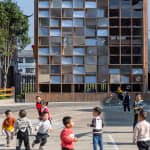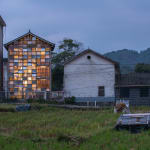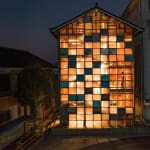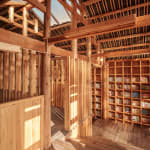-
Artworks










Pingtan Book House / The Mainland
Condition_Lab / Hong KongFurther images
-
(View a larger image of thumbnail 1
)

-
(View a larger image of thumbnail 2
)

-
(View a larger image of thumbnail 3
)

-
(View a larger image of thumbnail 4
)

-
(View a larger image of thumbnail 5
)

-
(View a larger image of thumbnail 6
)

-
(View a larger image of thumbnail 7
)

-
(View a larger image of thumbnail 8
)

-
(View a larger image of thumbnail 9
)

-
(View a larger image of thumbnail 10
)

-
(View a larger image of thumbnail 11
)

DFA Design for Asia Awards 2022 l Grand Award
A Small House for Big Hearts
Located in an elementary school campus in Pingtan Township, Tongdao Dong Autonomous County in Hunan Province, the Pingtan Children’s Library is a small, three-storey timber house that plays a much larger role in the community than its physical size. Underneath a façade covered with translucent polycarbonate boards, the only non-local materials used, a pair of double helix staircases lead to bookcases and views of the countryside on every landing.
The two spiral staircases are intended to stir the students’ imagination and creativity. “Imagine a staircase that never ends, an infinite loop of risers and treads squeezed into a traditional timber house. The staircase has no destination; it is the destination itself”, as the design team at Condition Lab describes the project. It is a space for kids to read, learn, socialise, play – a new paradigm for school libraries in rural China.
Instil ethnic and community pride
All the timber was sourced locally, and the structural beams and columns joined by traditional mortises and tenons. The tilted pitch roof dovetails with another school building, and is a tribute to Dong minority vernacular architecture. While the schoolchildren can recognise the familiar architecture, the façade and light-hearted stairway design are both contemporary, and unique in the area of China.
The book house, as the library is called in Chinese, instils ethnic and civic pride in its young users. The typical timber structure rises alongside the generic school buildings, awakening a sense of wonder, as it is a form of living heritage to teach the children to appreciate their culture as they engage with it directly. They are learning that the Dong minority culture is still relevant in a work of contemporary architecture of which they can be proud. As it acknowledges the traditional timber architecture with a modern twist, the library prepares the schoolchildren for the challenges of a modernising China.
Rebuilding social fabric
Like many villages in remote parts of China, Pingtan suffers from depopulation as working adults leave the village for better paying jobs in cities. The Pingtan Children’s Library is the second building in the area designed by Condition Lab and the Chinese University of Hong Kong’s School of Architecture. The Gaobu Book House, ten kilometres upstream, was the first. The team involved the local community in both projects, first earning the trust of the villagers, then securing a donation for the construction work and enlisting the help of local carpenters. Together they have added to the communal narrative and rebuilt social fabric for lasting impact.
-
(View a larger image of thumbnail 1
)











